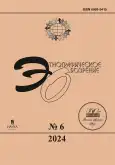Dividual in Zaimka, and Zaimka as Dividual: Ethnography of a Siberian Hut through the Prism of Female Absence
- Авторлар: Rakhmanova L.Y.1
-
Мекемелер:
- Higher School of Economics – Saint Petersburg Branch
- Шығарылым: № 6 (2024)
- Беттер: 41-65
- Бөлім: Special Theme of the Issue: Economic Anthropology of Household Outside Metropolitan Areas in Contemporary Russia
- URL: https://journal-vniispk.ru/0869-5415/article/view/276264
- DOI: https://doi.org/10.31857/S0869541524060035
- EDN: https://elibrary.ru/VTYQAU
- ID: 276264
Дәйексөз келтіру
Аннотация
The article explores ethnographically how taiga and river huts in the Middle Ob River, which exist in their rhythms in parallel with rural and urban forms of life, transform gender roles and qualities that do not fit into the notions of proper behavior and practices of men and women – neither as understood by local residents nor from the researcher's point of view. On the one hand, zaimka, which includes various buildings, is a landscape phenomenon, remarkable for its non-trivial position in the space between the wild taiga, the village, and the city. On the other hand, where a masculine world order seems to reign, zaimka problematizes gender divisions and shows that it is the female “constitutive” absence that is critical and influential. Drawing on the experience of shared hut visits, conversations, rumors, and joking, I show how gender duality is dismantled not through the notion of the “individual” at the hut, but through the distribution of masculine and feminine elements in the space of hut life with the help of the notion of “dividual” as a “distributed personhood” in the spatial dimension and “distributed self” as a language for describing different forms of subjectivities.
Негізгі сөздер
Толық мәтін
Авторлар туралы
Lidia Rakhmanova
Higher School of Economics – Saint Petersburg Branch
Хат алмасуға жауапты Автор.
Email: muza-spb@yandex.ru
ORCID iD: 0000-0002-7475-3609
к. социол. н., старший преподаватель
Ресей, Saint PetersburgӘдебиет тізімі
- Abashin, S. 2016. I zdes’, i tam: transnatsional’nye aspekty migratsii iz Tsentral’noi Azii v Rossiiu [Here and There: Transnational Aspects of Migration from Central Asia to Russia]. In Vostok na Vostoke, v Rossii i na Zapade: transgranichnye migratsii i diaspory [East in the East, in Russia and in the West: Cross-Border Migrations and Diasporas], edited by S. Panarin, 159–176. St. Petersburg: Nestor-Istoriia.
- Aleksandrov, N.M. 2012. Vliianie othozhih promyslov na social’no-demograficheskoe razvitie poreformennoi derevni (po materialam Verhnego Povolzh’ia) [Influence of Migrant Labors’ Crafts on the Socio-Demographic Development of the Post-Reform Village (On the Materials of the Upper Volga Region]. Ezhegodnik po agrarnoi istorii Vostochnoi Evropy 2: 333–343.
- Bateson, G. 2021. Naven: A Survey of the Problems Suggested by a Composite Picture of a Culture of a New Guinea Tribe Drawn from Three Points of View. Stanford: Stanford University Press.
- Bibikhin, V.V. 2011. Les [Forest]. St. Petersburg: Nauka.
- Deacon, T.W. 2012. Incomplete Nature: How Mind Emerged from Matter. New York: Norton.
- Ferguson, J. 1985. The Bovine Mystique: Power, Property and Livestock in Rural Lesotho. Man. New Series 20 (4): 647–674.
- Gell, A.1998. Art and Agency: An Anthropological Theory. Oxford: Clarendon Press.
- Gell, A. 2006. The Art of Anthropology: Essays and Diagrams. New York: Berg.
- Gillison, G.S. 1980. Images of Nature in Gimi thought. In Nature, Culture and Gender, edited by C. MacCormack and M. Strathern, 143–173. Cambridge: Cambridge University Press.
- Hamayon, R. 2012. The Three Duties of Good Fortune: “Luck” as a Relational Process among Hunting Peoples of the Siberian Forest in Pre-Soviet Times. Social Analysis 56 (1): 1–18.
- Haraway, D. 2015. Anthropocene, Capitalocene, Plantationocene, Chthulucene: Making Kin. Environmental Humanities 6: 159–165.
- Kazarinov, L. 1926. Othozhie promisly Chuhlomskogo uezda [Labor Migrants’ Crafts of the Region of Chukhloma]. Chukhloma.
- Kohn, E. 2018. Kak mysliat lesa: k antropologii po tu stronu cheloveka [How Forests Think: Toward an Antrhopology Beyond the Human]. Moscow: Ad Marginem Press.
- Plyusnin, Y.M., Y.D. Zausaeva, N.N. Zhidkevich, and A.A. Pozanenko. 2013. Otkhodniki [Wandering Workers]. Moscow: Novyi Khronograf.
- Rakhmanova, L.Y. 2019. Rybaki i kontroliruiushchie instantsii na Obi: pravoprimenenie v teni lokal’nykh pravil igry [Fishermen and Supervisory Instances on the Ob’ River: Law Enforcement in the Shadow of Local Rules of the Game]. Etnograficheskoe obozrenie 4: 45–60.
- Rakhmanova, L.Y. 2023. Hidden Dimensions of Clandestine Fishery: A Misfortune Topology Based on Scenarios of Failures. In The Siberian World, edited by J.P. Ziker, J. Fergusson and V. Davydov, 393–404. Abingdon; New York: Oxon; Routledge.
- Rakhmanova, L.Y. 2024. Intertwined Narratives: Nature Tourism in the Context of forced Settlers’ History in Western Siberia. Landscape Research. Special Issue. https://doi.org/10.1080/01426397.2024.2383471
- Read, K. 1984. The nama Cult Recalled. In Ritualized Homosexuality in Melanesia, edited by G.H. Herdt, 211–247. Berkeley: University of California Press.
- Seleev, S.S., and A.B. Pavlov. 2016. Garazhniki [Garage Co-operative Society Dwellers]. Moscow: Strana Oz.
- Ssorin-Chaikov, N.V. 2003. The Social Life of the State in Subarctic Siberia. Stanford: Stanford University Press.
- Ssorin-Chaikov, N.V. 2012. Gobbs v Sibiri: sotsial’naia zhizn’ gosudarstva. Sotsiologiia vlasti 1: 155–187.
- Strathern, M. 1988. Gender of the Gift: Problems with Women and Problems with Society in Melanesia. Berkeley: University of California Press.
- Strathern, M. 2004. Partial Connections. Savage: Rowman & Littlefield Publishers.
- Tsing, A.L. 2012. On Nonscalability: The Living World is not Amenable to Precision-Nested Scales. Common Knowledge 18 (3): 505–524.
- Tsing, A.L. 2015. The Mushroom at the End of the World: On the Possibility of Life in Capitalist Ruins. Princeton: Princeton University Press.
- Tutorskiy, A.V. 2023. Bears as Pares: Some Notes on Bear Stories in Zapinejie (Arkhangelskaya Oblast, Northern Part of the Russian Federation) and the Tendency to Equality in Human-Bear Relations. In Bear and Huma: Facets of a Multi-Layered Relationship from Past to Recent Times, with Emphasis on Northern Europe, edited by O. Grimm et al., 3: 887–899. Belgium: Brepols Publishers.
- Yunger, E. 2020. Ukhod v Les [The Forest Passage]. Moscow: Ad Marginem Press.
Қосымша файлдар













